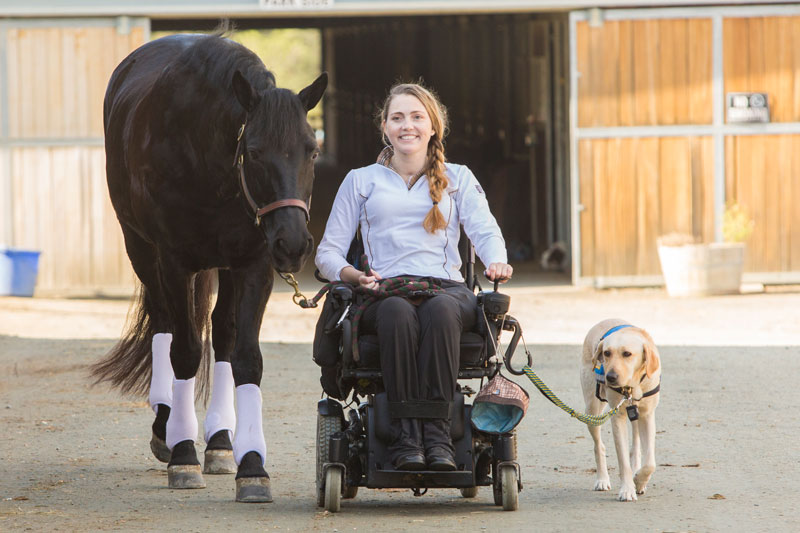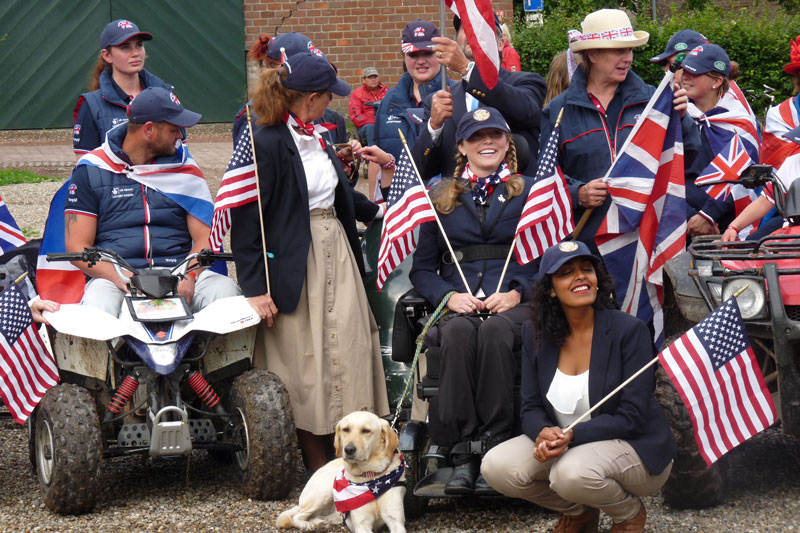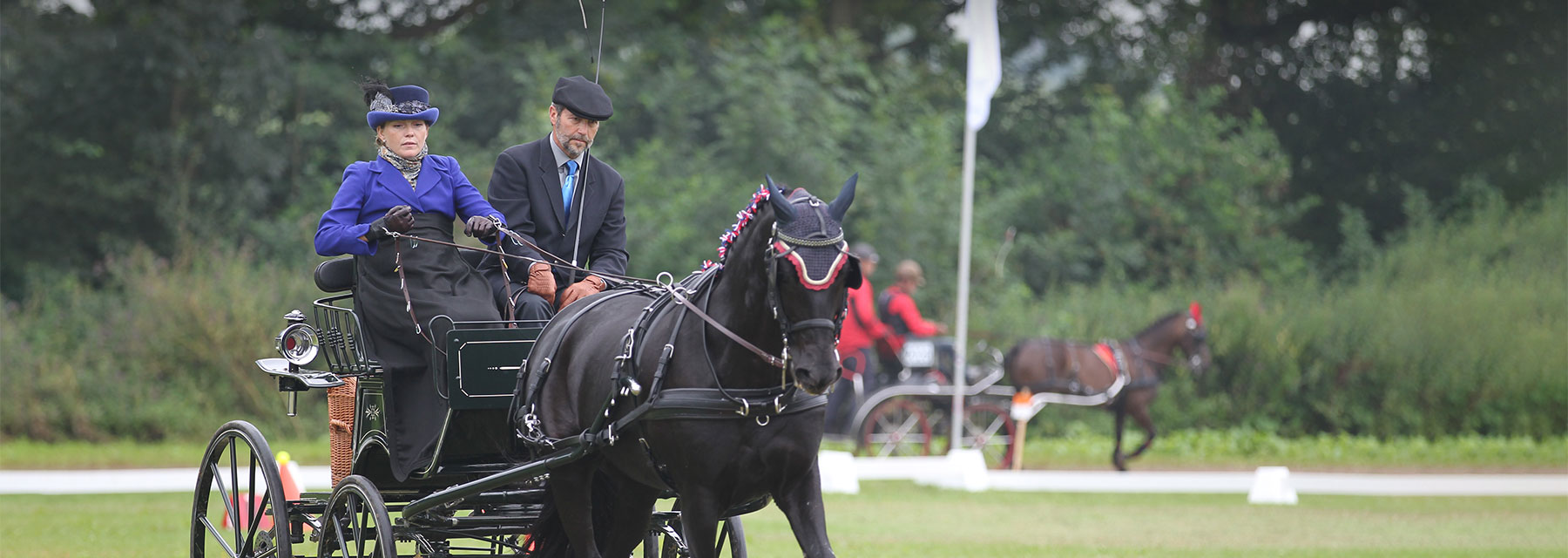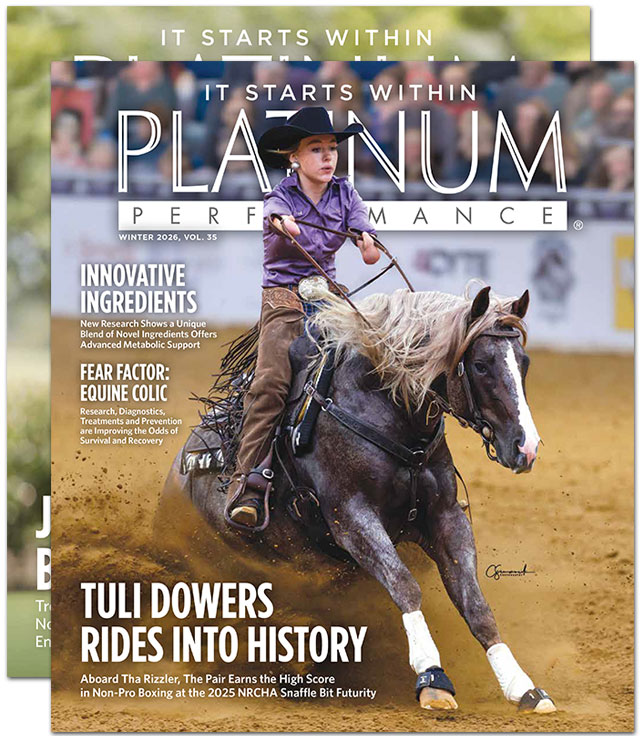Stefanie Putnam, who became a quadriplegic in 2009, took home fifth place at the Para-World Championships in carriage racing with her Morgan Horse gelding, Shadow.
Beyond a Shadow of a Doubt
Stefanie Putnam's Inspiring Story of Taking Up Carriage Driving & Earning Fifth at Para-World
Championships with Her Horse, Shadow
Life as Stefanie Putnam knew it changed completely after a non-equestrian related spinal cord injury left her paralyzed from the chest down. That was 2009. This is the story of how she, along with her horse, Shadow, discovered her new life. Today, Stefanie is making people re-think what being disabled means as she dazzles us from the seat of a carriage with Shadow on the other end of the reins. She's taken up driving and is competing around the world. After burning up three wheelchair motors, this spunky woman wants people that find themselves in her shoes to understand that life continues after tragedy. Her advice? “Put on some nice wheels and take up driving!” Her sport couldn't have asked for a better ambassador.
“Driving Shadow is what brought me alive again.”- Stefanie Putnam, Fifth-Place Finisher in Carriage Driving at the Para-World Championships Says of Her Horse After Life-Altering Trauma
Life Lessons at the Barn
During her elementary school years, Stefanie Putnam spent afternoons at the stable. She had fallen in love with all things equestrian when she was just a two-year-old bouncing in her saddle as her mother led the horse. As Stefanie puts it, “I was ready to ride straight from the womb!” Her mother, Marcia, was an American based in England who lived and trained in Europe for 13 years and would join her at the stable after her workday in the city had ended. Marcia taught her daughter to be a disciplined caretaker of the horses, teaching her how to clean the tack, and feed, clip and braid her own horses.
Putnam’s show career started in the Welsh pony hunters. Excited by the warmbloods and the big jumps, Stefanie eventually found her passion in show jumping. The strategic decisions about how to utilize her horse’s strengths intrigued her. She liked figuring out how to leverage the horse’s speed, stride or scope on a given course. This attention to detail and strategy continues to serve her well today.
She enjoyed a few other hobbies, played jazz trombone and participated in track and field but only when it didn’t interfere with a horse show. "It was always the horses," says Stefanie.
Horses & Courses
"I love courses. I love figuring out the obstacles. To look at a course and strategize the best way to shave time off my run is interesting to me. Is my horse fast? Does he have a long stride or maybe a lot of scope?" The building blocks of her show jumping career were coming together, and she was just beginning to develop her own style. Stefanie had a beautiful feel for a horse, "when I think about the courses and the ways the courses are ridden, the hands are so important. With the connection between the horse’s mouth and the rider’s hands, so much can be said so subtly. People with the quietest hands that really use their position, getting out of the horse’s way, but giving it everything it needs ... those connections I really respect. In jumping, you ride a lot of different horses. With driving, it’s more of a connection with a single horse."
“I dream every night. I dream about horses, but I am completely able-bodied. I ride them, I jump them, I tack them up...”- Stefanie Putnam
Trauma
In 2007, she earned her Bachelors degree in Graphic Communications and began working in San Francisco. Even as she started her career, the horses were still calling to her. She devised a plan to finish her Masters degree in advertising at the Academy of Art so she could, "make lots of money, buy myself an amazing horse and go to the Olympics!" That was the plan. That was the dream. She was 24 years old and started focusing on that goal for her future. One morning, Stefanie and her mom went for a trail ride, her last one as a fully-able-bodied rider. At the end of the ride, they put the horses away, said goodbye and she jetted off to her daily obligations. It was August 23rd, and school would resume soon.
Stefanie woke up at a trauma hospital two weeks later. She could feel nothing from the neck down. She assumed it was just a sting and that she would overcome it. "My body was healing. I thought ‘it just needs a little time.’ " The diagnosis was devastating. From her C7 vertebrae up to her C3 vertebrae, it had, as Stefanie puts it, "exploded." Her C5 vertebrae had been twisted in a way that doctors believed should have severed her spinal cord.
Aside from the sudden physical limitations, she and her family were forcibly thrust into decisions about therapy centers and fears of the unknown. She was unable to even sit up, frequently experiencing nausea and loss of consciousness. These side effects were frightening but typical of people in her condition. Scariest of all to her, though, was the thought of not being able to ride again. Medical personnel were honest with her about her potential future limitations. The outlook was bleak.
After her initial medical care, the family decided on a rehabilitation hospital in Colorado where recreational therapy was utilized to stimulate the body. That was where someone posed a question to Stefanie that changed everything. The physical therapist asked Stefanie what she wanted to be able to do. Stefanie replied with "I don’t know; what I can do. They said I won’t be able to do a lot of things," to which the therapist replied, "I don’t care what they said. What do YOU want to do?" With sudden permission to dream, Stefanie heard herself excitedly saying, "I want to ride horses, I want to swim, I want to ... " and she watched as the therapist wrote down every desire Stefanie named. "I thought that therapist was crazy!" That day, she began the process of re-building her life.
Back to the Barn
The family knew that Stefanie’s passion for horses was driving her desire for recovery. It was the thing that motivated her, pushed her, inspired her, again. "I know now that horses never leave your life if it was meant to be," ponders Stefanie. Her mother had the perfect "first" horse to re-introduce Stefanie to the barn. It was an older, retired endurance horse that awaited her. When she finally got to the barn, both excited and terrified, Stefanie worried the horses would be afraid of her power wheelchair. "I was really scared. You know, I used to be this person who rode all the time. At that point, I hadn’t been around a horse in months. It was the longest I’d ever been away from the horses." Her mom wouldn’t tolerate the fear. She remembered who Stefanie really was better than Stefanie did. As her daughter was citing all the things that were sure to go wrong and all the things she couldn’t do, Marcia walked toward her daughter and dropped the lead rope on her lap. "Meet me in the upper pasture," she said, walking away.
Accustomed to having people accompany her every moment since her injury, Stefanie suddenly had to figure out how to take the first step on her own. It forced her to squelch her own fear and engage in the long process of trial and error. With the horse obediently standing next to her, she tried to hold onto the rope as she moved her chair, but the lead rope fell. She knocked it with her shoulder, trying to re-group for another try. The horse patiently waited for her and began to follow when commanded by a tug from the wheelchair. She stopped several times to reposition her hand. Again, the gelding waited. Stefanie could feel the familiar connection to the horse and was overwhelmed by it. "I’ve never felt it with a human. It’s soul to soul." Slowly, inch-by-inch, the pair made the trek to the upper pasture. "We eventually made it to the pasture. Mom was right. I was wrong," she says with a smile in her voice. After that, all she could think about then was actually RIDING a horse again.

PHOTO BY CHRIS KITTREDGE
Discovering Driving
While Stefanie was in the rehabilitation hospital, she was put onto a western saddle, but it didn’t provide the support she needed to hold herself upright. Once back home, Stefanie and her mom investigated therapeutic riding centers and ultimately heard about carriage driving. It was a discipline that could give Stefanie a chance to be with horses again. (Never, did they imagine she would compete again.) At Marcia’s insistence, Stefanie decided to try carriage driving! Once she was aboard the carriage and harnessed in, someone held Stefanie’s shoulders back, and she drove from her lap, at a walk. "I thought to myself ‘wow. This is where I’m supposed to be!’"
In competition, carriage driving is comprised of three phases: Driven Dressage (where the teams are judged on obedience and freedom of motion), Marathon (a cross-country challenge where stamina and obedience is tested) and Obstacle Driving (where courses are set up with obstacles that the pair must navigate with speed and accuracy). This sport had everything Stefanie loved: skill, strategy and adrenaline.
She soon "broke out of the wheel chair," as she puts it, with help from a company in Colorado that makes seats for the para-Olympic hockey and ski teams. They fashioned a seat for her from a used hockey shell, and Marcia asked a harness maker to create breakaway leather cuffs that connect to the reins. They punched holes in the reins at regular intervals and attached key chain holders to create a way for Stefanie to ‘hold’ the reins. Getting into the carriage was complicated at first, using a lift and a power chair. But, they continued to modify and innovate. The transition to the carriage was eased by first driving a marathon carriage (usually used for combined driving). This allowed her to initially have a co-pilot with a second set of reins in case of an emergency while she was learning to drive. The evolution had begun. Less than one year since her injury, her rebirth was underway. "I dream every night. I dream about horses, but I am completely able-bodied. I ride them, I jump them, I tack them up. My mind thinks I’m completely whole. It refuses to accept that there is any limitation."
Recovering function below the site of a spinal cord injury was once thought impossible. People who suffer injuries like Stefanie’s were thought to have a lifelong condition of paralysis with no hope for improvement. Now, researchers are combining advances in basic biological research with technological innovation, allowing some patients with spinal cord injuries to see improved movement over time. Stefanie and many others are proof of this. As she says, "anything is possible."
Shadow (Bethesda After Dark)
Unexpectedly, Stefanie and her mom found themselves sitting on the bed, going through her old show clothes. "It was surreal," said Stefanie. She never thought she’d be competing again! But after just one show, she was becoming connected to people in the driving world. Through the support of the driving community, Stefanie was starting to see a future for herself again. That’s how Shadow came into her life in 2012. Having Shadow, an experienced driving horse with his own accolades, created an opportunity to get excited about creating and pursuing dreams. Stefanie with her former experience as a show jumper had a strong equestrian foundation. "Muscle memory" was beginning to kick in and so were her competitive ambitions!
"With Shadow, he’s somehow been able to give me tools with his vast abilities. He has an old soul and since he came into my life, incredible things have happened to me." For instance, when Stefanie first started going back to the barn, she noticed that the side effects commonly experienced by people who are paralyzed (like nausea as well as blood pressure and body temperature regulation) would inexplicably cease when she arrived at the barn. That is still true for her today.
A large part of her recovery came after she ‘decided’ what she wanted her life to look like. "I broke that boundary where I could choose to be miserable or choose to find a way to make myself incredibly happy. I won’t be defined by my injury. My soul hasn’t changed. I am still Stefanie. Just like with our horses. Sometimes, our horses sustain injuries, but they still have the same heart and soul."
Stefanie’s doctors also began to notice that her body was starting to change. A vocal cord that had been paralyzed was strengthening from her giving verbal commands to Shadow. Her voice was now audible. There were muscles where she shouldn't have them, due to her level of paralysis. Though she still had only very limited movement from her chest down, she was building her shoulder, upper back and bicep muscles, regaining remarkable arm strength and function, and even some trunk control. People started noticing the improvements in functionality and movement. With the muscle memory of equitation pumping through her veins, it was reminding her body how to behave. "I knew what it looked like, and how it felt. My body was trying to do what it knew from before my injury."
"I have so little control in the world, so to be able to be responsible for something builds my confidence and makes me want to see the next phase of progress. I can control how my horse is maintained, how I strategize my ride, the apex of the turns, determining my slide. I have a job to help this team. There are mechanical elements of my discipline like the carriage and the harness. There is an animal component, Shadow, and there is me, the human part."
Stefanie discovered the United States Driving for the Disabled and came into contact with many other drivers with disabilities who provided an inspiration and guidance. She learned about the FEI Para-Equestrian Driving World Championships and also met several world champions. Stefanie was able to add her voice and presence to further advance the visibility of these remarkable people. "I was trotting through, and people wanted to ask me questions and take photos of what I was doing." What she and other drivers with disabilities are doing provides the pebble that is being tossed into a pond of possibility. The ripples are reaching people throughout the equestrian world and beyond. They are showing people what is possible.
Stefanie soon heard about the 2016 Para-World Championships similar to the Paralympics (there are no Olympic Driving events either able-bodied or Para for the driving discipline currently) and began training for it. "I caught wind of the Para-World Championships. The second I heard about it, I set a goal to be there." She trained hard and soon realized that the physical therapy exercises she had been prescribed were identical to the movements required to control the carriage. "I dropped physical therapy, occupational therapy and mental therapy. The horses were what was helping me most!"

PHOTO BY MARIE DE RONDE-OUDEMAN
Para-World Championships
When the summer of 2016 came around, Stefanie and her supporters traveled to Europe to spend several more weeks training before the championships. She was the only driver chosen by USEF to represent the United States attending, and she wasn’t sure what to expect. But Shadow had been on a big stage before and comforted her as she prepared. When the dust settled at the Para-World Driving Championships at the end of the summer, Shadow and Stefanie, in their first international debut together against seasoned international competitors, had claimed an amazingly impressive fifth place!
The equestrian industry celebrated her achievements with several awards, including a nomination for the 2016 USEF Equestrian of the Year, winning the American Driving Society Driver of the Year, USEF Becky Grand Hart Trophy and American Morgan Horse Association’s International Award. These include able-bodied competitors and are not specifically for the disabled.
Like so many of us, Stefanie had once dreamed of being an Olympic Show Jumper, and here she was actually doing it but in a different equestrian discipline with a disability no less. When asked about her accomplishments, Stefanie is humble and quick to deflect praise to her horse and her team of supporters. "Anything is really possible, and my injury has actually made me a better collaborator with my horse and my team."
Beyond The Shadow
Besides driving, Stefanie is now spending time with several causes, including serving as the spokesperson for the United States Driving for the Disabled, as well as Canine Companions. She also recently consulted with Google to aid in the development of new product lines that will benefit the physically disabled.
Riding horses didn’t cause her to be injured, it taught her what she needed to overcome an injury. You don’t learn perseverance in a crisis. You practice perseverance in a crisis. Stefanie learned it in the daily details of her life before the injury: grooming, cleaning, feeding, doctoring, falling off, getting back on, winning, losing, keep trying. Not only did horses prepare her for this, Shadow brought her through it and delivered her to a new place of possibility. "It’s so interesting that when you think all is lost and all is over, this little gem kind of pops up, and for me, it was driving. Driving Shadow is what has brought me alive again. It brings joy to my life. How have I been so lucky?"

by Amy Quintana
Platinum Performance®

